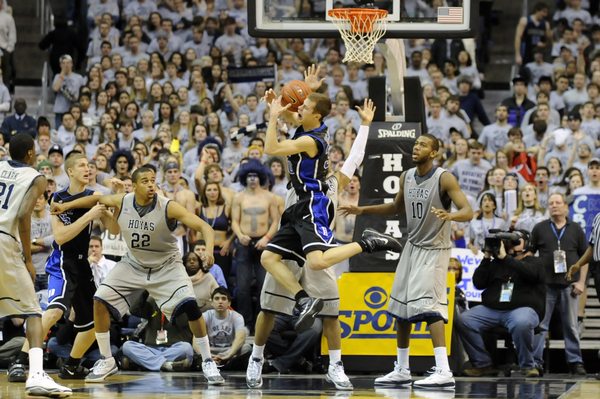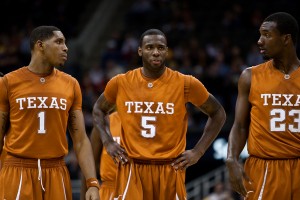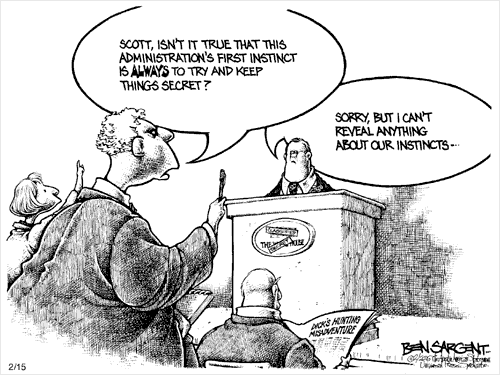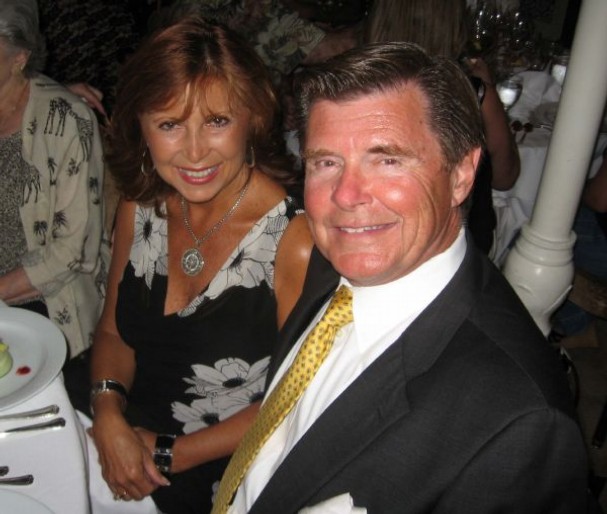Ten Tuesday Scribbles… (With a Wednesday Twist)
Posted by zhayes9 on February 3rd, 2010RTC contributor and bracketologist Zach Hayes will deliver ten permeating thoughts every week as the season progresses.
This week’s Scribbles column will look ahead to a couple months down the road in Indianapolis, where 65 deserving teams will be whittled down to just four, and to that blissful Monday night in April when one lucky group will be dancing at mid-court to the tune of One Shining Moment. In my estimation, there are ten squads with a promising-to-slight chance of hoisting a 2010 National Champions banner during their home opener next season. I’m here to tell you those ten teams, why they have hopes of winning a national title, what’s holding them back, and the most realistic scenario as I see it come late March or beginning of April. These teams are ranked in reverse order from 10-1 with the #1 school holding the best cards in their deck.
10. Duke
Why they can win it all: Their floor leader and senior stalwart Jon Scheyer is the steadiest distributor in all of college basketball, evident from his incredibly stellar 3.28 A/T ratio and a 5.6 APG mark that ranks third in the ACC and 23d in the nation. Scheyer is also a deadly shooter coming off screens when he has time to square his body to the basket, nailing a career-high 39% from deep to go along with 44% from the floor overall. Duke is also a tremendous free-throw shooting team as a whole and Coach K has the ability to play a group of Scheyer-Kyle Singler-Nolan Smith-Mason Plumlee-Lance Thomas that doesn’t feature one player under 70% from the charity stripe. Duke also features a ton more size in the paint than during previous flameouts in the NCAA Tournament. When Singler plays small forward, Coach K can rotate Miles and Mason Plumlee, the glue guy Thomas, rebounding force Brian Zoubek and even Ryan Kelly at two positions with no player under 6’8. You’d be hard-pressed to find a more efficient backcourt in the nation than Scheyer and Smith. And it’s widely known that exceptional guard play is the ultimate key to winning in March.

What Makes Duke 2010 Different than Duke 2006-09?
Why they won’t win it all: Depth could certainly be an issue for the Blue Devils’ chances of raising their first banner since 2001. Andre Dawkins has fallen almost entirely out of the rotation and Coach K has started to limit Mason Plumlee’s minutes during important games. Also, Brian Zoubek’s tendency to immediately step into foul trouble limits his availability. It wouldn’t shock me to see Duke play Scheyer, Smith and Singler 40 minutes per game during their time in the NCAA Tournament. That could cause those key players, who rely primarily on their jump shot, to lose their legs and start throwing up bricks. Kyle Singler isn’t quite the superstar he was last season, either. Singler’s numbers are down across the board — scoring, rebounding, FG%, 3pt% — and he’s been dealing with a nagging wrist injury that may not improve in the weeks and months ahead. Duke also lacks the athleticism of teams like Kansas, Kentucky, Syracuse and Texas. They could struggle with quicker guards like John Wall and athletic rebounders of the Damion James mold.
Likely scenario: I see Duke reaching the Sweet 16 as a #2 seed where they fall to a more athletic, quick group of guards that can explode to the rim and draw fouls. Duke may have height, but most of that height just isn’t a threat offensively by any stretch of the imagination. Eventually getting into a jump shooting contest could be the Blue Devils’ downfall if two of Smith, Scheyer and Singler go cold.
9. West Virginia
Why they can win it all: Da’Sean Butler is one of the best players in the nation when the chips are on the table. If the Mountaineers need a big shot to keep their season alive, Butler will demand the basketball and more than likely deliver. He’s downed Marquette and Louisville on game-deciding jumpers and led the second half charge against Ohio State. West Virginia is also supremely athletic and Bob Huggins’ teams always crash the boards with a tremendous ferocity. No contender can match the height across the board that West Virginia touts other than Kentucky. Huggins has experimented with lineups in which all of his players are 6’6 or taller, including 6’9 Devin Ebanks acting as a point-forward and 6’7 Da’Sean Butler capable of posting up smaller two-guards. Sophomore Kevin Jones is an incredible talent and a rebounding machine (7.7 RPG) that hits 55% of his shots from the floor and 44% from deep. West Virginia has the luxury of any of their forwards being able to step out and drain a mid-range jumper, from Ebanks to Jones to Wellington Smith to John Flowers every once in a full moon.
Why they won’t win it all: Let’s face it: Bob Huggins doesn’t have exactly the best track record when it comes to NCAA Tournament success. Huggins hasn’t reached the Elite 8 since 1995-96 with Cincinnati and only one Sweet 16 in the last ten years. In 2000 and 2002, his Bearcats lost just four games all season and yet didn’t reach the second weekend of March both times. Most also question whether the Mountaineers can hit outside shots on a consistent basis. They’ve struggled mightily in the first half of Big East games and can’t afford to fall behind against elite competition in March like they did against Dayton last season. Point guard play is a prudent question for West Virginia, as well. Joe Mazzulla is a quality perimeter defender and a capable distributor, but he’ll never be the offensive threat he was two seasons ago due to that shoulder injury. Darryl Bryant can certainly catch a hot streak shooting-wise, but in all honestly he’s more suited as an undersized two-guard. Bryant is averaging just 3.6 APG in 25+ MPG of action.
Likely scenario: I’m still fairly high on this team. I love Butler at the end of games and Ebanks can do anything for Huggins — from score to rebound to run the point — and Kevin Jones is one of the most underappreciated players in the Big East. In the end, I see a clankfest from outside ultimately costing West Virginia their season. And for all their rebounding history, the Mountaineers are in the mid-60s in the nation. The Elite Eight seems like a proper place for their season to conclude.
8. Texas
Why they can win it all: No team boasts better perimeter defenders than Texas. Anyone that watched Dogus Balbay completely shut down James Anderson in the second half Monday night knows he’s the best perimeter defender in the nation, even stronger than Purdue’s Chris Kramer. Avery Bradley came in with the reputation as an elite defender and he’s certainly lived up to that billing. Even J’Covan Brown off the bench is a capable defensive player and Justin Mason is a plus defender. When Dexter Pittman stays out of foul trouble, Texas boasts a legitimate shot-blocking presence that can negate quick guards on the rare occasion they slip past Balbay or Bradley. Texas is also the deepest team in the nation and Rick Barnes has the capability of playing 10 or 11 men on any night if he feels the need. The preserved minutes could pay dividends in the form of fresh players come March. Damion James should also be on a mission come March as a senior. He’s never reached a Final Four during his Longhorns career and came back for a fourth year in Austin to accomplish that very feat.





























![45409112722_WVU_v_Texas_A&M[1]](http://rushthecourt.net/wp-content/uploads/2010/02/45409112722_WVU_v_Texas_AM1.jpg)






![95208122242_Oklahoma_v_Rice[1]](http://rushthecourt.net/wp-content/uploads/2009/10/95208122242_Oklahoma_v_Rice1.jpg)


![465081206020_Duke_at_Michigan[1]](http://rushthecourt.net/wp-content/uploads/2009/08/465081206020_Duke_at_Michigan1.jpg)












